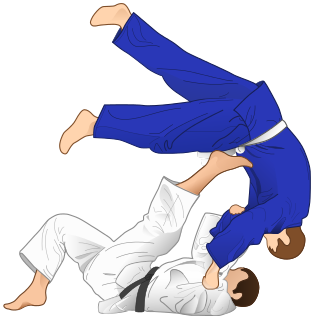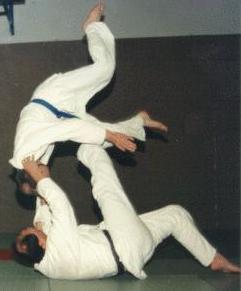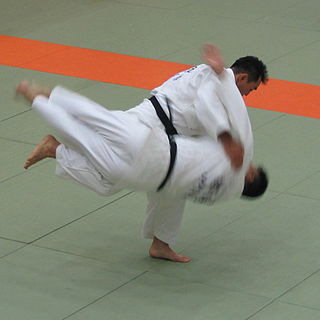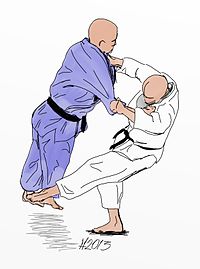
Nage-no-kata is one of the two randori-no-kata of Kodokan Judo. It is intended as an illustration of the various concepts of nage-waza that exist in judo, and is used both as a training method and as a demonstration of understanding.

In martial arts, a throw is a grappling technique that involves off-balancing or lifting an opponent, and throwing them to the ground, in Japanese martial arts referred to as nage-waza, 投げ技, "throwing technique". Throws are a subset of takedown (grappling). Certain throwing techniques called sacrifice throws involve putting oneself in a potentially disadvantageous position, such as on the ground, in order to execute a throw.

Deashi Harai (出足払), more accurately romanized: Deashibarai, is one of the original 40 throws of Judo as developed by Jigoro Kano. It belongs to the first group, Dai-Ikkyo, of the traditional throwing list, Gokyo-no-Nagewaza, of Kodokan Judo. It is also part of the current 67 Throws of Kodokan Judo. It is classified as a foot technique, Ashi-Waza. Deashi Harai is also one of the 20 techniques in Danzan Ryu's (DZR) Nagete list.

Sasae Tsurikomi Ashi (支釣込足) is one of the traditional forty throws of Judo as developed by Jigoro Kano. Sasae Tsurikomi Ashi belongs to the first group, Dai Ikkyo, of the traditional throwing list, Gokyo, of Kodokan Judo. It is also part of the current 67 Throws of Kodokan Judo. It is classified as a foot technique, Ashi-Waza.

Osotogari (大外刈) is one of the original 40 throws of Judo as developed by Jigoro Kano. It belongs to the first group, Dai Ikkyo, of the traditional throwing list, Gokyo, of Kodokan Judo. It is also included in the current 67 Throws of Kodokan Judo. It is classified as a foot technique, Ashi-Waza.
Yama Arashi is one of the preserved throwing techniques, Habukareta Waza, of Judo. It belonged to the fifth group, Dai Gokyo, of the 1895 Gokyo no Waza lists. It is categorized as a hand throwing technique, Te-waza. It rarely occurs in competition or randori.

Harai goshi (払腰) is one of the original 40 throws of Judo as developed by Kano Jigoro. It belongs to the second group of the traditional throwing list in the Gokyo no waza of the Kodokan Judo. It is also part of the current 67 Throws of Kodokan Judo, and classified as a hip technique (koshiwaza). Harai goshi is also one of the 20 techniques in Danzan ryu's Nagete list as well as one of the 18 throws in the Kar-do-Jitsu-Ryu martial arts system. English terms include "Sweeping hip throw" and "Hip Sweep".

Yoko Gake (横掛) is one of the original forty throws of judo as developed by Jigoro Kano. It belongs to the fifth group, Gokyo, of the traditional throwing list, Gokyo, of Kodokan Judo. It is also part of the current 67 throws of Kodokan Judo. It is classified as a side sacrifice technique, Yoko-sutemi. Considered one of the techniques most dangerous for the Uke, its use in competition is infrequent; contributing to the risk is that Uke does not have sufficient space to dissipate the impact of the fall adequately. Another contributing factor is the necessity for Uke to compensate in order to achieve proper rotation in executing the breakfall; if the Uke does not succeed in meeting these criteria, the force of the impact can be severe, even to the point of possible spinal injury. For these reasons, the technique is generally reserved for expert judoka.

Ashi guruma is a throw in judo. It is one of the original 40 throws of Judo as developed by Kano Jigoro. It belongs to the third group of the traditional throwing list in the Gokyo no waza of the Kodokan Judo. It is also included in the current 67 Throws of Kodokan Judo and is classified as a foot technique (ashiwaza).

Harai Tsurikomi Ashi (払釣込足) is one of the original 40 throws of Judo as developed by Jigoro Kano. It belongs to the third group, Sankyo, of the traditional throwing list, Gokyo, of Kodokan Judo. It is also part of the current 67 Throws of Kodokan Judo. It is classified as a foot technique, Ashi-waza.

Osoto Otoshi (大外落) is one of the preserved throwing techniques, Habukareta Waza, of Judo. It belonged to the fourth group, Yonkyo, of the 1895 Gokyo no Waza lists. It is categorized as a foot technique, Ashi-waza.
Harai Goshi Gaeshi (払腰返) is a hip sweep counter in judo. It is one of the techniques adopted later by the Kodokan into their Shinmeisho No Waza list. It is categorized as a foot technique, Ashi-waza.
Hane Goshi Gaeshi is a throw in judo and is categorized as a foot technique, Ashi-waza. It is one of the techniques adopted later by the Kodokan into their Shinmeisho No Waza list.

A sweep is either of two categories of martial arts techniques. From standing, sweeps are throws or takedowns that primarily use the legs to attack an opponent's legs. On the ground, sweeps are techniques for reversing a grappling position from a guard position.
Gonosen-no-kata is a judo kata that focuses on counter-attacks to throwing techniques. It is not an officially recognized kata of judo, but its importance is attested to by its inclusion in Kawaishi's The complete seven katas of judo. Writing in the early post-war period, Kawaishi described the kata as being practiced less in Japan than in Europe.
Practice of Kaeshi no Kata is almost entirely limited to Great-Britain, where until today it has been understood as a judo kata which, like the Gonosen-no-kata, focuses on counter-attacks to throwing techniques. The kata was commonly explained as being an older form than Gonosen-no-kata, that was passed onto Ōtani Masutarō from Tani Yukio.
Tsubame Gaeshi (燕返し) is a Judo throw that falls within the seventeen techniques of the Shimmeisho no waza, officially recognised by the Kodokan in 1982. Literally translated as "Swallow Counter", Tsubame gaeshi is the countering of an ashi waza with Deashi harai from the opposite leg. A right-handed Deashi-harai executed by uke, for instance, would be avoided by tori bending his right knee, followed by a left-handed Deashi-harai. Tsubame gaeshi as a counter against uke's Deashi harai is the opening move of the Kaeshi-no-kata. As a counter against Okuriashi harai, it forms the sixth technique of the Nage-Waza-Ura-no-kata.
Karate's Nage waza is the set of techniques whereby the opponent is thrown to the ground. While typical students of karate focus most of their attention on learning striking techniques, karate throws are considered indispensable for self-defense and, although not always taught, are part of the classical art.

















